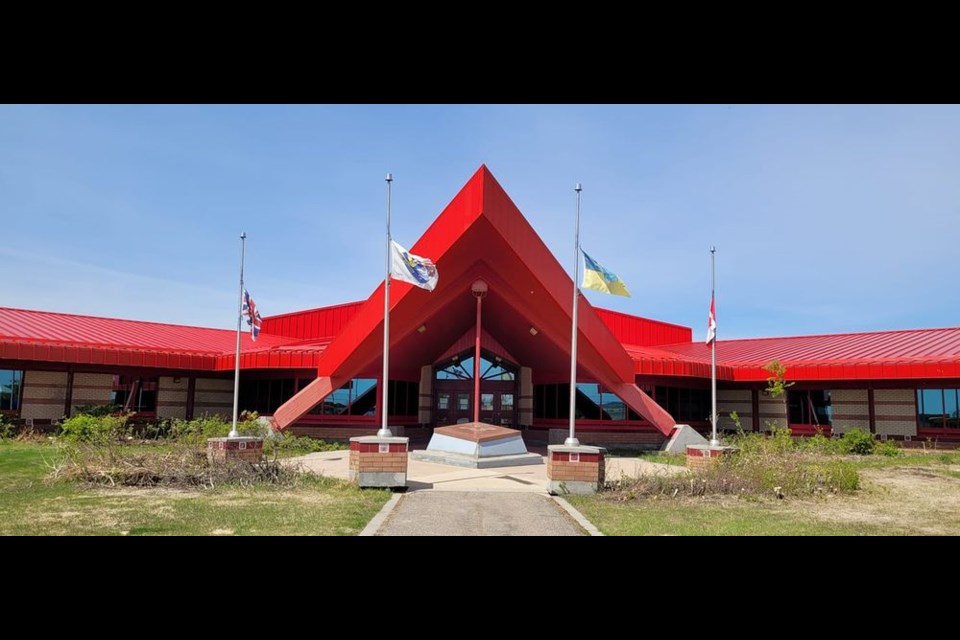Indigenous communities across Canada have been forced to once again deal with the pain and suffering that has come from Canada’s residential school system. Using ground penetrating radar technology, the Tk’emlúps te Secwépemc First Nation has reported an unsettling discovery of an unmarked mass burial of 215 Indigenous children, some as young as three years old, who attended what was formerly Canada’s largest residential school. The news has opened old wounds for many survivors and sent waves of grief across the nation.
It was an emotional day for residential school survivor and Elder, Reggie Severight, who attended the St. Phillips Residential School as a child. The day school, which was originally built in 1927, was located next to the Keeseekoose First Nation. It was open between the years of 1928 to 1969, and at its peak, the school had 132 resident students in the 1964/65 school year.
Severight delivered the opening prayer at the С����Ƶ. Josh Badger sang an honour song. ��Chief George Cote and Kamsack Mayor Nancy Brunt spoke, paying tribute to the victims, the survivors and their families.
Despite not С����Ƶ a part of the Canadian school curriculum, stories of horrific physical, sexual and emotional abuse have been painfully shared within Indigenous communities for decades. In addition to the 215 bodies in Kamloops, the remains of another 35 children have been discovered in an unmarked burial site at the site of the former residential school located on the Muskowekwan First Nation in Saskatchewan. With widespread stories of abuse and numerous witness accounts from Elders, a number of organizations and individuals are now petitioning the government to investigate all sites of former residential schools in Canada.
“We are calling on the federal government to recognize what has happened, be part of the process and help us uncover the truth so we can move forward and continue to heal,” shared Chief George Cote.
Canada’s first prime minister, Sir John A. Macdonald, who is commonly known as the “father of confederation” was also one of the founders of the network of residential schools for First Nation, Inuit and Metis children that aimed to strategically remove children from their homes and use inhumane methods to punish them for speaking their language or practicing their culture.
According to reports from the Truth and Reconciliation Commission of Canada (TRC) – a body mandated to tell the truth about residential schools in Canada, in addition to forcing children into hard labour and enduring all forms of abuse from both priests and nuns, many children were reportedly malnourished, underfed, and sometimes used as test subjects in so-called scientific studies. Many of the residential school children’s deaths were never documented and of those that were, the cause of death was often not shared with next of kin.
An excerpt from the eBook entitled, Shattering the Silence, The Hidden History of Residential Schools in Saskatchewan, prepared by Shuana Niessen for the Faculty of Education, University of Regina, details interviews with survivors from the Kamsack area:
Elaine Durocher found the first day at the Roman Catholic school in Kamsack, Saskatchewan, to be overwhelming.
“As soon we entered the residential school, the abuse started right away. We were taken up to a dormitory, stripped. Our hair was sprayed.… They put oxfords on our feet, ’cause I know my feet hurt. They put dresses on us. And were made, we were always praying, we were always on our knees. We were told we were little, stupid savages, and that they had to educate us.”
Durocher felt that she received no meaningful education at the school. Rather, she learned the tools for a life on the fringes of society in the sex trade.
“They were there to discipline you, teach you, beat you, rape you, molest you, but I never got an education.”
During an interview on Feb. 18, 1992, William Whitehawk of Kamsack recalled priests who were sexually active, in two cases with schoolboys, and in one with Indian women on the reserve near St. Philip’s school. At the Community Hearing in Key First Nation, Saskatchewan, in 2012, Whitehawk said he was glad that he disclosed his abuse.
“I don’t regret it because it taught me something. It taught me to talk about truth, about me, to be honest about who I am…I am very proud of who I am today. It took me a long time, but I’m there. And what I have, my values and belief systems are mine and no one is going to impose theirs on me. And no one today is going to take advantage of me, man or woman, the government or the RCMP, because I have a voice today. I can speak for me and no one can take that away.”
A report entitled, The Residential School System, By Erin Hanson (2009), with updates and revisions by Daniel P. Gamez & Alexa Manuel (September 2020) detailed the following conclusions regarding the ongoing impact of residential schools in Canada:
“The residential school system is viewed by much of the Canadian public as part of a distant past, disassociated from today’s events. In many ways, this is a misconception. The last residential school did not close its doors until 1996, and many of the leaders, teachers, parents, and grandparents of today’s Indigenous communities are residential school Survivors. Although residential schools have closed, their effects remain ongoing for both Survivors and their descendants who now share in the intergenerational effects of transmitted personal trauma and loss of language, culture, traditional teachings, and mental/spiritual wellС����Ƶ.”
��




